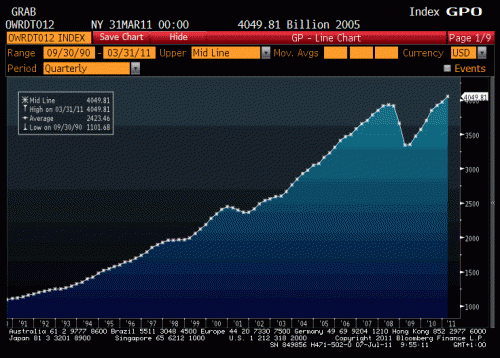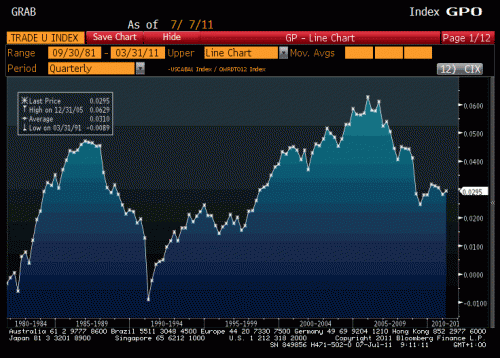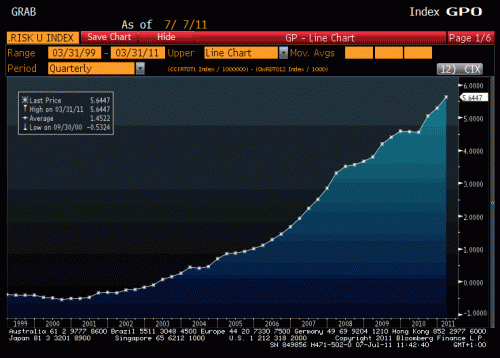Financing world trade – Buy the dollar
The US has consistently run a current account deficit for decades. Doing so, makes it hard for the US Government to reduce deficits since This is not just because of a plummeting household savings rate. It is also because the USD is the world’s reserve currency. In that context, from time to time I have talked about the incompatibility of a national currency being a global reserve currency. This is the Triffin Dilemma. Here’s my read of what this has meant for the global financial system:
it is clear that the US dollar’s role as a reserve currency is part of the problem that has led to massive and destabilising global macro imbalances. The problem: national currencies don’t work as global reserve currencies. For the US dollar to be an effective reserve currency, the US must run a large current account deficit in order for foreigners to build up US dollar reserves via their corresponding capital account deficit. So, the US dollar’s role as a reserve currency requires the US to run trade deficits ad infinitum.
While this could be sustainable over the short run, invariably these deficits build, leading to recrimination and instability or worse when recession hits. For example, after the Asian Crisis in the late 1990s, Asian countries were quite keen on building up a buffer of US dollar reserves to prevent a similar episode in future. The result has been a mercantilist trade policy designed to promote current account surpluses and capital account deficits in Asia in order to build reserves. Much the same dynamic has been occurring all around the emerging markets, in Russia and Brazil in particular. EM countries have built a massive amount of reserves that reflect external imbalances with the US. We now see the protectionist rhetoric that this kind of unevenness creates. And eventually, rhetoric turns into action unless a buoyant economy dampens the calls for protectionism.
So there is a natural tension for the US between its role as global reserve currency creator and its domestic agenda to reduce current account deficits and increase the domestic private sector savings rate. I am speaking of the Triffin dilemma of course. Belgian-American economist Robert Triffin first brought these tensions to light in the 1960s during the Bretton Woods days. But they have not gone away even after the breakup of Bretton Woods in the early 1970s.
Basically, you’re not going to reduce deficits if the domestic private sector wants to spend less than its income and foreigners are accumulating dollars. As long as the dollar is the world’s reserve currency, the only way to get around the government deficit is to depreciate the dollar, which some hoped zero rates and quantitative easing could help do. The trade deficit as a percent of world trade has halved from 6% to 3%. So, you’re going to really need much more than we have seen- a major devaluation, a reduction of reserve currency status or a private sector binge. Of course, zero rates come with a carry trade side effect that increases financial fragility as I outlined in the last post.
I don’t see how you fix this unless you accept the government budget deficits, continue to have destabilising and speculative binges in the private sector to reduce savings or ditch the dollar as the reserve currency. Those are the three levers, public sector, private sector, and foreign sector. There are no real alternatives.
That’s my read of what the Triffin Dilemma is telling us.
Here’s Andy Lees of UBS with a slightly different take this morning:
Chart 1 shows world trade (goods and services) has reached new all time highs although not yet recovered to the pre-2008 trend.
Chart 2 shows that the US current account deficit as a % of world trade has fallen from 6.3% to 2.9%. This means that since the peak there are less dollars being pumped into the system from the current account deficit than the growth in trade, most of which is still settled in dollars.
The Triffin Dilemma says that the US has to run a current account deficit because if it runs a surplus, it sucks dollars out of the system shrinking the money supply of international dollars and thereby causing deflation or contraction in world trade. At the moment it is not that extreme, but insufficient dollars are getting into the system from the US current account deficit to finance the growth in global trade, so the stock of these international dollars is falling relative to the value of world trade. This means the dollars are either getting in through other means to finance global trade, or as appears to be happening over the last couple of months, global trade will have to slow.
Dollars have clearly poured into the system from speculative capital -(almost certainly on the back of QE) – which means that there is a risk behind it. People are short dollars and at some stage they will have to be bought back. A lot of those dollars have come from European banks borrowing dollars, or from US banks increased exposure to Europe – (recent BIS data showed US banks exposure to peripheral Europe is USD640bn for example). The short can go on for a long time, but with QE2 now ended, with talk of a tax immunity for bringing profits back home, and with the Brent/Texas oil spread getting back towards its all time highs – (Citigroup expect Brent to rise to a premium of USD40 or more to West Texas compared with the present premium of USD17bbl, presumably putting European industry at a severe disadvantage) – and hopefully the US about to address its budget deficit, the cost of holding that short dollar position, let alone growing it which would be necessary for the divergence to continue, seems set to rise.
Chart 3 shows the divergence between world trade and global FX reserves has gone exponential since 2002 and almost vertical over the last year to USD5.6447trn. Reserves accumulated within the private sector from companies that are happy to sit on them would add to this divergence but lets just concentrate on this USD5.6trn. Some of that capital flow will be FDI and a lot will be short term speculative money. That figure is up by over USD1trn in the last year alone and up USD2.1trn since June 2008 and up by USD5.6trn since June 2003 which is USD700bn a year. The figures are astounding.
The longer the divergence continues between the growth in world trade and the growth in the US current account deficit, unless that trade is being done in another currency, the higher the percentage of speculative dollars must be in the stock of international dollars meaning a greater risk of a violent unwind and a big dollar squeeze. With QE2 now ended, I am not willing to run the risk of this turning; the risks of being short the dollar are just too high.
Sounds like Andy is dollar bullish. I would also add that we saw a huge surge in the USD during the panic in 2008 and 2009, presumably because the same forces were at play. When I hear talk of European sovereign debt crisis contagion, I think a lot about US money market funds de-funding European banks and creating the pre-conditions for those central bank swap lines being used all over again. Why regulators are allowing these institutions to become exposed to short-term dollar funding is beyond me. So in the end I agree with Andy that being dollar short exposes one to a potentially violent reversal when the dollar is the reserve currency in a world of uncertainty. That could prove painful.



Don’t you have the causation wrong here? The real reason the ca is huge is because foreigners accumulate dollars via trade. In other words, they want to do business with America. The reserve currency aspect has nothing to do with it. We are the reserve currency because of our huge economy and demand and massive demand for goods. It’s not the result of the reserve status. The reserve status is a result of being the worlds largest economy.
No, I don’t have the causality wrong. Foreign central banks want to accumulate dollars because this gives them the ammunition necessary to deal with the kinds of speculative attacks we saw in Argentina, Russia and Asia. The desire of Asian central banks to accumulate dollars is well-documented. And the reserve status is not the result of being the world’s largest economy, the eurozone is equal in size. Reserve currency status for the US is the result of the legacy of Bretton Woods and multilateral negotiation just as the British pound’s status before the USD was the result of the same.
No, you’re still missing a basic point. China accumulates dollars bc of trade. Those dollars go to the central bank and get used to protect their currency so they can boost trade. It all starts with the fact that China desires high trade surplus with the USA. The reserve currency has nothing to do with China’s desire to save in us dollars.
No, China accumulates dollars because it has pegged its currency at a rate that allows it to do so. The trade surplus and dollar accumulation is driven by the peg.
They peg their currency bc they want to do business with America bc it helps employ millions of Chinese and help drive growth. Not because America has reserve currency status. Again, you have the causation totally wrong.
It’s really a bit of both. The mercantilism and the reserve accumulation go hand in hand. Take a nuanced approach. See here for example:
Focusing on the ten EMCs that doubled their reserves since 1999, three distinct groups emerge, as Figure 1 shows: (i) current account surplus countries (Russia, Ukraine and Malaysia) (ii) capital account surplus countries (the Czech Republic, Mexico, Romania and South Africa); and (iii) countries that experienced both current and capital account surpluses (China, India and South Korea). Dividing the rapid accumulators into groups is helpful in terms of structuring the discussion on the underlying motives for accumulation.
https://www.ecb.int/pub/pdf/scpops/ecbocp73.pdf
And note that China does not have a trade surplus with Germany for example. That tells you the causality is more complex (savings rates, reserve accumulation, mercantilism, exchange rates) than you are trying to indicate.
From the paper:
“Under the floating exchange rate regimes…there is in principle no need to hold reserves for intervention purposes if the float is fully free.”
China’s Mercantilist policies are their choice. Not the result of the US dollar being a reserve currency.
Another option is to reform the IMF and eliminate the requirement of debt issue for Federal dollar expenditure. If debt issue were used strategically rather than universally it would be the tool needed to manage our foreign balances. To take the fright out of this power for our trading partners the IMF should be used for its original purpose of balancing trade and currency flows instead of in its post Nixon role as neo-classical imperialists trojan horse.
Mike Shedlock points to a nice post (at least it helped me understand it) by Michael Pettis on the effect of trade imbalances – here https://globaleconomicanalysis.blogspot.com/2011/07/hugo-salinas-price-and-michael-pettis.html